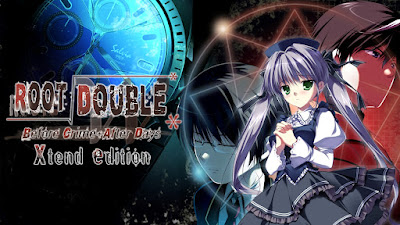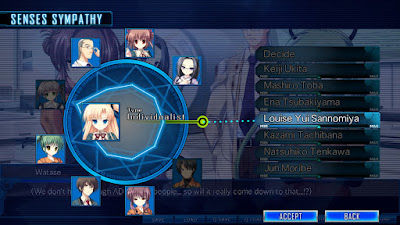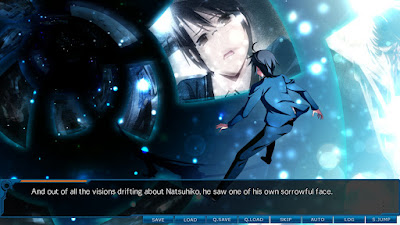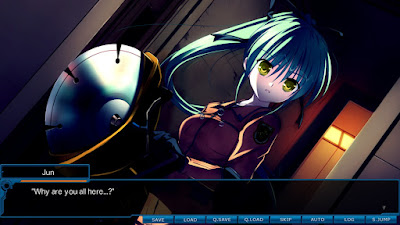Root Double: Before Crime * After Days is a visual novel for the PC and other console systems. It is set in 2030 where the characters are trapped in a lockdown of a nuclear research facility, and they’re in a race against time as they attempt to survive and find a way out. It’s a classic visual novel where the story is the main draw, the game is comprised mostly of reading interspersed with sections where you make choices to influence the developments and the ending that you will achieve.
The only input from the player comes from the Senses Sympathy System. Instead of specific choices at decision points for the player to pick, instead, these points allow the player to adjust the protagonist’s impressions of other characters. To be honest, this can be quite confusing, as you would have little idea during your first playthrough on whether to increase or decrease the meter, even more so when there are multiple characters’ gauges to adjust. These directly influence the endings you’ll get though so these decision points are extremely important.
The game is split into four routes, and the Xtend Edition has a new ending. The Root A (for “After”) route follows Watase Kasasagi, a rescue worker sent to the research centre just before the lockdown before becoming trapped in there. He’s joined by his two colleagues Tachibana and Moribe. In this route, we quickly learn about the situation of the game and the predicament the characters find themselves in. The facility houses a nuclear reactor, whereby an accident has occurred, resulting in a meltdown.
Now, with radiation levels starting to rapidly rise, the facility has locked down and cannot be accessed by outsiders until nine hours as passed. The trio must find a way to survive the nine hours. There is a theoretical drug called AD that helps them nullify the negative effects of the radiation but they must inject themselves with it once per hour. Thereby, the story resolves from the characters desperately searching for AD to finding more survivors to finding an escape and eventually discovering the secrets of the facility.
The story immediately grips, first off with the dangers of a nuclear meltdown, and then later on with developments into cause of the accident. It becomes clear that there are sinister movements happening in the background, and the facility is much more than it seems at first glance. Things rapidly escalate and it does not shy away from being dark with its subject matter. Corpses, murders, blood, they’re all here and it really shows how despairing the situation is.
With that said, there are times where the story switches to typical visual novel fashion with hints at romance and minor sexual references. It can feel out of place but they’re quickly brushed away to return to the serious situation at hand. The first route takes around four hours to finish if you read at a fast pace, although the ending does not resolve anything, it just raises a lot more questions that the other routes will probably address.
The second route, Root B (for “Before”), can be played before or after Root A, but if you’re completing the routes in alphabetical order than this will be second. It follows the other cast that had sporadically appeared in Root A. Here, it follows four high school students, with the protagonist before Natsuhiro. It follow the events that leads up to what we see in Root A. As a result, it starts a few days before the accident in the research centre and takes the time to slowly introduce the high school characters.
Unfortunately, after the gripping fast paced Root A with its mysteries, Root B feels sluggish and bland in comparison. It feels like a completely different game and story, as it is more akin to the slice-of-life stuff you see in romance visual novels. While it follows a pattern, it still takes quite a while before things start to take shape and even then, it feels light on content. There is a heavy tendency for flashbacks, which is kind of annoying when it ends up being a flashback within a flashback. It also takes a significant time before the route catches up to the events of Root A, which is what most players would be caring about by this point.
It takes around four to five hours to finish Root B as well, and there are several big revelations at the point where it converges with the beginning of Root A. Some of these revelations you would have probably guessed, especially since it is fairly cliched, while others are clever in their own right and is a satisfactory reason for why certain events were the way that they are.
Finishing both Root A and Root B will unlock Root C (for “Current”). This finally brings the story back to where it began. It shows a new perspective to the events of Root A, clarifying a lot of questions that you would have had while playing. It slotted into perfectly. Root C is a short route, designed as an intermission of sorts, for the player to catch up, so it only takes around 45 minutes to complete and has no bad endings. That said, when it finally reached its ending, it nicely summarises the questions remaining, and they were good questions. The promise of resolving all these questions in the fourth and final route is too enticing to ignore. After the relative blandness of Root B (although it gave required information to fully understand the events), Root C brings back the intense addictive storytelling from Root A, while promising more.
Root D (for “Double”) is the final chapter that brings the story to a close. This is a longer chapter, on par with Root A, so around four to five hours. This chapters brings everything together neatly and explained pretty much all the questions it had raised. It’s one revelation after another and it does not disappoint. That said, it tends to drag on a bit, especially with its decision to go through each of the nine characters’ pasts in such detail, to the point of the structure feeling repetitive and predictable.
Nevertheless, with everything that has happened up until this point, you realize that there were so many events it’s crazy how far the current situation has evolved. It’s unrecognizable at times and the events of Root A feels so far in the distant past. The solution to their problem, the disaster of the research lab, and how everyone escapes, was fine. By this point, as so much time was spent on understanding the characters, everyone’s actions feel justified and you care about their fates. In abundance to the multitude of bad endings, there are also several alternate endings. The two good endings are just that, good, but not perfect.
The later releases (including this PC release) has the Xtend Episode, which has extra content. It’s not as much as you would expect and it’s quite disappointing. It sets to explore the motivations and backgrounds of the characters even more so than the story, but presents it as in chronological order, which means around 70% of the content is rehashed scenes and text from the main story. You have to go through these same “memories” in order to get to the new content, which is short. It’ll take around two hours to get through and most of that is skipping scenes you’ve already seen. So all in all, the game takes around twenty hours to complete if you read fast and follow a guide.
Overall, Root Double: Before Crime * After Days is a fantastic visual novel. Visual novels live and die by the story that they tell, and this game tells an amazing story. It immediately grips you, and while the second route has a bit of mood whiplash swapping to a slice-of-life high school drama that eventually wraps back to the current disaster, it’s an intricately planned story that brilliant in its execution. The choice system can be annoying and hard to tell which is the correct route at times but the story and the themes it explores is well worth the effort.
-----------------------------------------------------
For other game reviews, have a look at this page.













